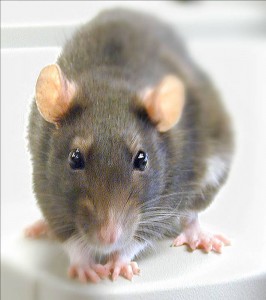Roof rats cause millions of dollars of damage each year, from contamination of food products, spreading diseases, structural and automotive damage caused by their continual gnawing activities.
The roof rat is the smallest, of two non-native rodents, sharing our urban environment today. The roof rat is extremely compatible with human behavior and needs, resulting in them living in close proximity to man, by harboring in the landscape, under a deck or in the attic of a home. The omnivorous roof rat will feed on vegetable matter, including buds, seeds of ornamental plants, backyard fruit trees, bird feeders, pet food and compost bins.
Identification
The two most troublesome rats, are two introduced species. The roof rat and norway rat. It is important to know which species is present, in order to devise the most effective management program. Roof rats are slightly smaller than norway rats and unlike the norway rat, their tails are longer than their head and body combined. The Table below summarizes some identifying characteristics.
Disease
Roof rats are considered public health hazards because of their ability to transmit a variety of diseases such as plague, maurine typhus, rickettsial pox, leptospirosis and salmonella. In addition, they may be a source of swine dysentery, brucellosis, sarcoptic mange and tuberculosis.
Biology & Habits
Roof rats bear their young in nests 21 to 33 days, after conception. At birth, rats are hairless and their eyes are closed. The 5 to 8 young, in the litter, develop rapidly and grow hair within a week. Between 9 and 14 days, their eyes open and they begin to explore for food and move about, near their nest. By three weeks of age, the young begin to take solid food. Around three months of age, they are completely independent of their mother and reproductively mature.
The number of litters depends on a variety of factors such as: climatic range, availability of nutritious food, density of the local rat population and the age of the rat. Typically, three or more litters are produced annually.
Rats usually begin searching for food shortly after sunset. When necessary, roof rats will travel considerable distances (100 to 300 feet) for food. They may live in the attic or landscape of one residence, while feeding at another. If food is in an exposed area and too large to be eaten quickly, but not too large to be moved, they will usually carry or drag it to a hiding place before eating it. Many rats may cache or hoard considerable amounts of food, which they eat later. Rats tend to segregate themselves socially in both space and time. The more dominant rats occupy better habitats and feed whenever they like, while the less fortunate may have to occupy marginal habitats and feed when more dominant rats are not present.
Physical Abilities
The understanding of a roof rat’s abilities is essential. For example, roof rats can run along or climb electrical wires, pipes, fences, poles, cables, vines, shrubs and trees. They are capable of climbing almost any vertical, textured surface, such as wood, brick, concrete, weathered sheet metal, inside and outside vertical pipes. In addition, the roof rat can crawl horizontally along or through pipes, augers, conveyors, conduit underground utility and communication lines with at least a Vz” diameter. Roof rats are known to gnaw through a wide variety of materials, including lead, aluminum sheeting, window screens, wood, rubber, vinyl, fiberglass, plastic and low quality concrete or mortar. The roof rat can jump 36″ vertically and as far as 48′ horizontally. They can swim as far as ‘/•> mile in open water, dive through water traps in plumbing, travel sewer lines against a substantial current and gain entry through holes equal or larger than 1/2′”.

Damage
Damage, by roof rats has been documented to homes, apartments, hotels, office complexes, retail businesses manufacturing facilities, food processing facilities and warehouses.
Inspection
Proper identification is the first step of any control measure. The identification provides insight into the biology, habits and physical abilities of the specific species, we are dealing with. Next, is a thorough inspection of the structure. At a minimum, the tools required to provide a proper and thorough inspection are a bright flashlight, inspection mirror, ladder and the ability to listen. A rodent control expert will have a detective’s mind set. This will include interviewing customers for information about sightings and sounds. The rodent expert, thinking three dimensionally, will inspect the entire exterior of the structure, looking for points of entry.
The clues, in the attic, will give a history and magnitude of the infestation. By observing, runways or paths, made in insulation, the location and concentration of droppings, urine stains, gnaw marks tracks and rub marks indicate rodent pathways. Observing unusual pet behaviors, with their keen sense of smell and hearing are often the first indication of an invader. Following a thorough inspection, a control program can be tailored to your particular situation.
Management
For controlling rats indoors, only traps are used. Baiting is best done outdoors and only after all points of entry have been proofed. Otherwise, rats may die inside, resulting in an undesirable smell, generally from an inaccessible area that require cutting a hole in the wall to remove the carcass. After a home is rat proofed, the traps should be checked on a daily basis until the catch ratio drops. If night time scratching, chewing and running noises are causing you to lose sleep at night, call us today for a free consultation.
